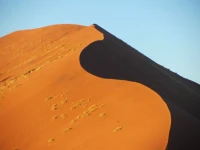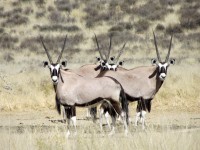After leaving the arid and rocky south around the Fish River Canyon, we started heading north towards the red dune area of Sossusvlei. On our way we stopped off in the Tirasberg. We turned north from the Keetmanshoop – Lüderitz road, and on to the Tiras Plain, located between the Rooirand (Escarpment) and the south eastern foothills of the Tiras Mountains. This area came as a complete surprise to us. The Tiras Mountains are the intersection of several different landscapes. In the southeast, where we were, is short shrub savannah. The last thing we were expecting to see was grasslands!
Since 1998 there has been a 125,000 ha (125 km²) large private nature reserve in this area. The Tirasberg Conservancy is an area set aside by four neighbouring farms – Gunsbewys, Tiras, Landsberg and Koiimasis. This is one of the Wildlife Conservancies I mentioned in my Impressions Of Namibia post. We were staying on Farm Tiras – a working farm specializing in livestock breeding.

The Farm Tiras homestead. It was late afternoon and the grasslands were glowing in the soft light. ©WMB/notesfromafrica.wordpress.com

The “hunter’s cabin” where we were staying is situated up against this hill. ©LB/notesfromafrica.wordpress.com

The camp had on the left a bathroom block, open-air cooking facilities in the middle and a one-room cabin/bedroom on the right. ©WMB/notesfromafrica.wordpress.com

The sleeping cabin. ©LB/notesfromafrica.wordpress.com

Looking towards the open-air kitchen and bathroom block. ©LB/notesfromafrica.wordpress.com
The accommodation on Farm Tiras was the most basic we encountered during our visit to Namibia. But the views from the camp were extraordinary and made up for our bitter cold night there.

Sunset view of the Tiras Plain and Tiras Mountains ©LB/notesfromafrica.wordpress.com

Morning view of the Tiras Plain and the Tiras Mountains. ©LB/notesfromafrica.wordpress.com

©WMB/notesfromafrica.wordpress.com
In the morning we went into the wilderness areas of the farm, and took lots of photos of amazing rock formations and beautiful landscapes.

©WMB/notesfromafrica.wordpress.com

©LB/notesfromafrica.wordpress.com

©WMB/notesfromafrica.wordpress.com

There is a huge social weaverbird nest in the tree. ©LB/notesfromafrica.wordpress.com

Hardy plants growing in-between a pile of rocks. ©WMB/notesfromafrica.wordpress.com

©LB/notesfromafrica.wordpress.com

A huge egg-like boulder. ©WMB/notesfromafrica.wordpress.com

Passing through one of the cattle camps. ©LB/notesfromafrica.wordpress.com

©WMB/notesfromafrica.wordpress.com

©LB/notesfromafrica.wordpress.com
This post is part of a series I will be publishing about our travels through Namibia. It is also part of my daily posts for October 2016 – otherwise known as The October Dash


















Dry and dramatic! Wonderful rock shapes. A surprise there is any accommodation for the wayfarer at all!
Yes, the rocks are beautiful. This area has working farms, so isn’t as desolate as other areas were travelled through in southern Namibia. Most farms have B&B or guest farm facilities.
I’ve been curious about visiting the Tiras conservancy for a long time – it looks wonderful and intriguing. I love how your rustic chalet is tucked against the side of the rocky hill, and you have such beautiful views from there too. How ‘basic’ was the accommodation, Lisa? Was there electricity, gas, running water, bedding, kitchen stuff…?
There was running water, but I can’t remember if there was gas. There is no electricity and the bedding wasn’t amazing – if you stay there I’d suggest bringing your own. We always travel with a gas cooker and sleeping bags.
Oh, and I’d suggest basic cooking equipment too – don’t remember there being any. It sounded like they allow people to camp there too.
Thank you for the tips, Lisa!
We don’t have a 4×4 or any camping equipment, so these amazing out-of-the-way places in Namibia are a little out of our reach. I wish it wouldn’t be quite so exorbitantly expensive to hire a suitably equipped 4×4 inside Namibia. It’s why we usually end up going to B&Bs or SC places that don’t require too much gravel road driving. But in Namibia, it does limit one’s range rather! It looks like you and Willie can be completely self-sufficient on the road, if you need to camp somewhere.
Reggie if I remember correctly, there was a type of “shuttle” service to the dune area in Sossusvlei. So you left your car at the end of the tar road if you didn’t have a 4×4 vehicle.
Also at Tirasberg, I think there was a B&B option as well. The farmers in the area are usually open to providing an evening meal if you require it. The Farm Tiras owners were German and very friendly and welcoming.
Hi Lisa, nice to meet you. Thank you for visiting our blog and starting to follow it, it was a great thing, I found your amazing blog.
We are almost as far as possible from each others, South Africa and Finland. We just got our first snow and the weather is now -10°C.
Your post is full of beautiful photos!
Hi! Nice to meet you too. Most of my family still lives in Northern Europe, so I like the cold and the snow. Saw one of your recent photos and knew I had to follow your blog.
Thank you for visiting, commenting and following! 🙂
Hello,
Really nice post 🙂
We are very interested on visiting Tiras next year but I can’t find information about lodging options or a way to contact.
Do you have any suggestion?
Thank you!
Hi Martika! Thanks for your kind comment. 🙂 As far as I know the Tirasberg area consists of privately owned working farms. The various farms do offer accommodation to visitors though. I just have to find the info I have on these for you.